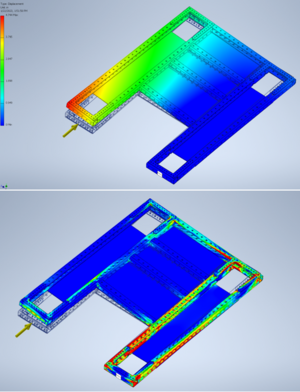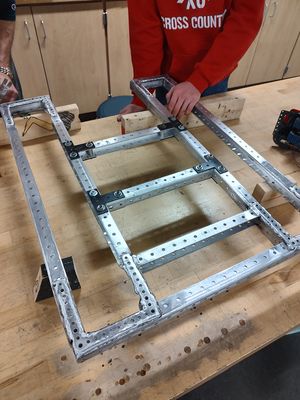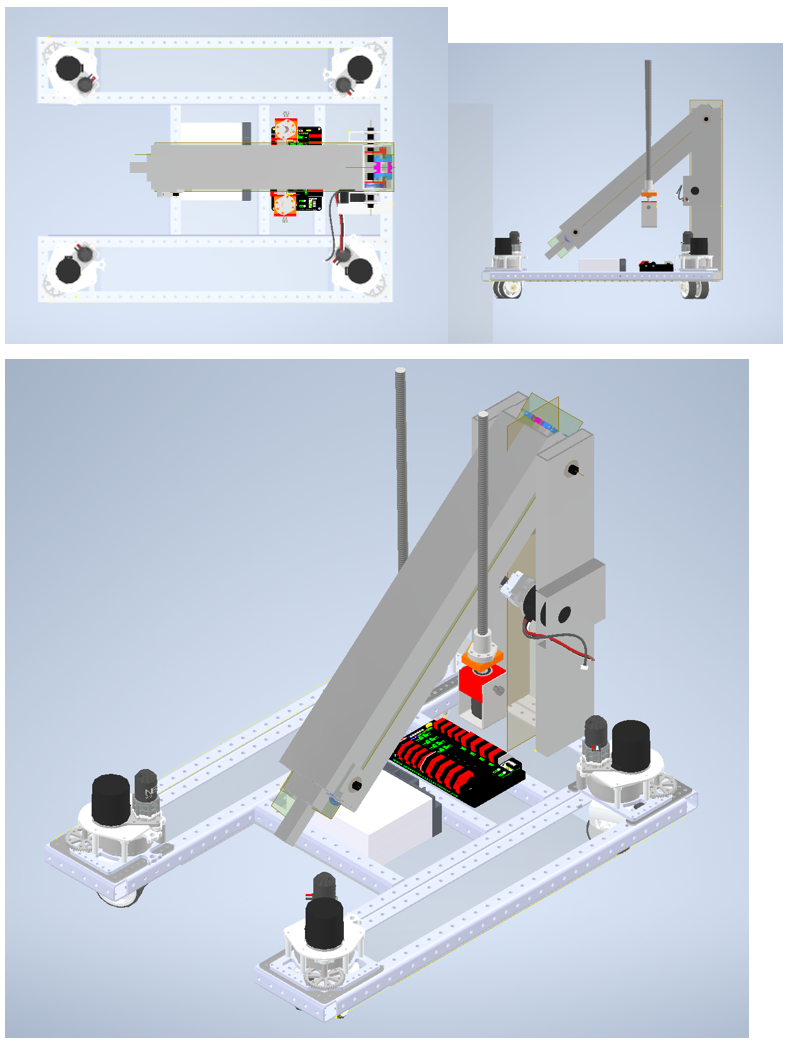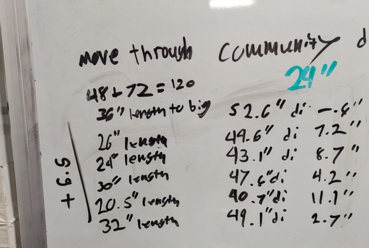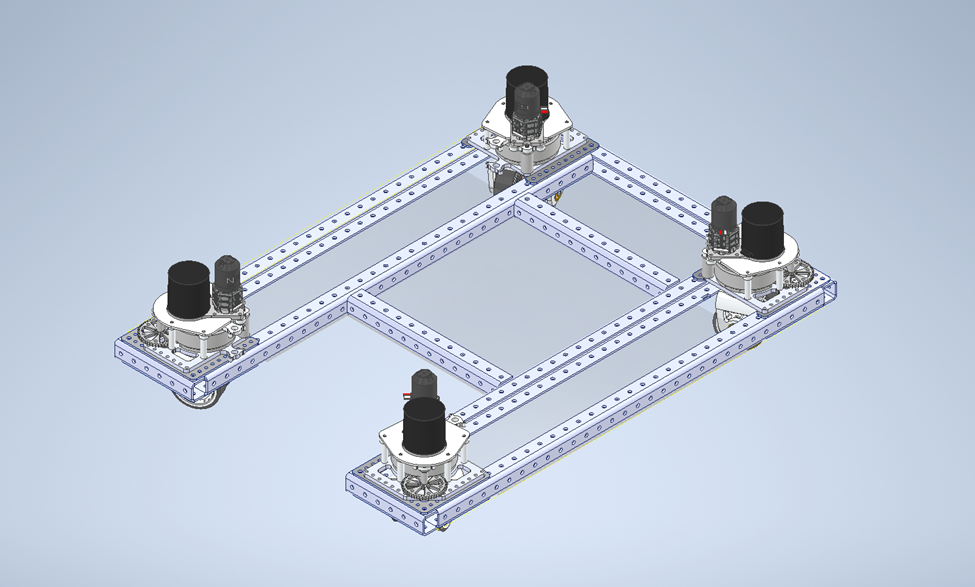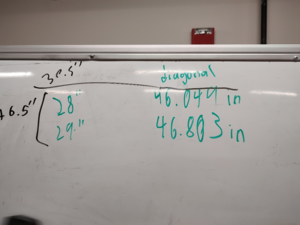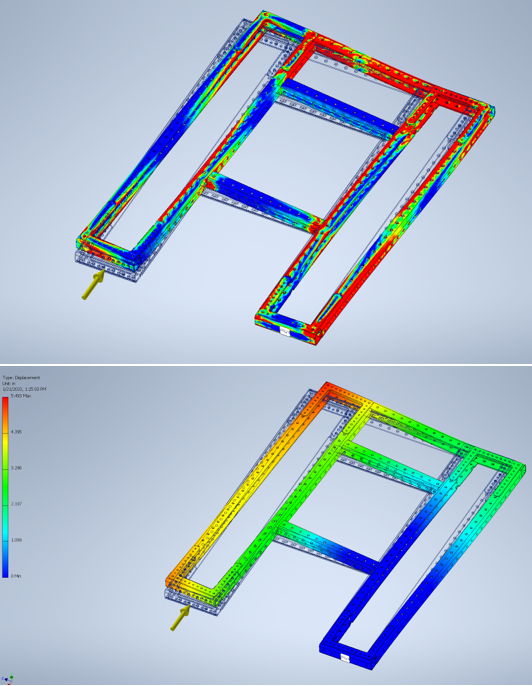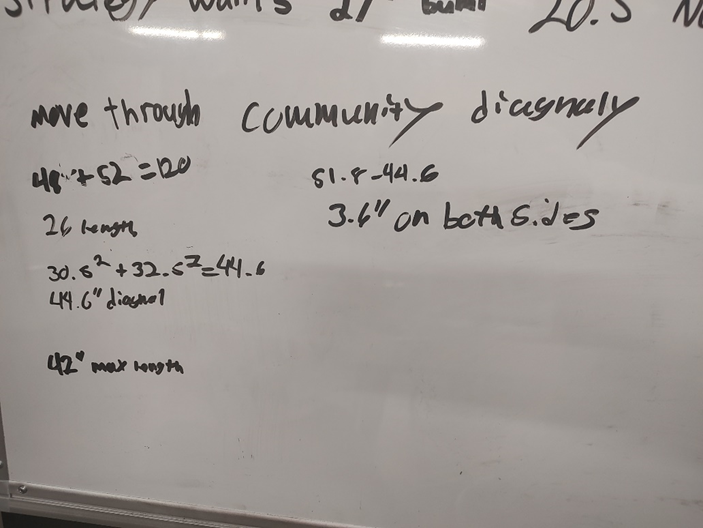2023:Drive Base: Difference between revisions
Mechanical1 (talk | contribs) (DB update 1/29/2023) Tag: visualeditor |
Programming (talk | contribs) (Added drive base pictures) Tag: visualeditor |
||
| Line 40: | Line 40: | ||
[[File:Battery Box.png|thumb|This is the final version of the battery box]] | [[File:Battery Box.png|thumb|This is the final version of the battery box]] | ||
Battery box broke, but we fixed it. Many changes were made to battery box height, width, depth, and mounting holes. We plan to mount it on the drive base at each of the four corners, and secure it with a strap. This strap will also serve as a way to lift the battery out of the box. We made a prototype of the parking break, and 3d printed a, "hockey puck" to mount on the bottom. This worked well, and stayed in its shape while under large amounts of force. Shop drawings were made for all drive base parts except those associated with the parking break. Lastly, the U-Brackets finally arrived! The drive base will be welded together and assembled by the next meeting. | Battery box broke, but we fixed it. Many changes were made to battery box height, width, depth, and mounting holes. We plan to mount it on the drive base at each of the four corners, and secure it with a strap. This strap will also serve as a way to lift the battery out of the box. We made a prototype of the parking break, and 3d printed a, "hockey puck" to mount on the bottom. This worked well, and stayed in its shape while under large amounts of force. Shop drawings were made for all drive base parts except those associated with the parking break. Lastly, the U-Brackets finally arrived! The drive base will be welded together and assembled by the next meeting. | ||
[[File:Welded Drive Base.jpg|thumb]] | |||
[[File:Electrical Drive Base Assembly.png|A few views of a proposed placement of the battery and PD board in the Lift and Drive Base assembly, made on 1/21/2023]] | [[File:Electrical Drive Base Assembly.png|A few views of a proposed placement of the battery and PD board in the Lift and Drive Base assembly, made on 1/21/2023]] | ||
[[File:Drive Base Calculations.png|369x369px|Below are the calculations for a drive base with a width of 24 inches without bumpers, and a variety of lengths. The left column is the side length without bumpers, the middle column is the diagonal distance with bumpers, and the right column is irrelevant. ]][[File:Drive Base Constraints.png|More qualitative drive base constraints]][[File:Field Layout.png|A basic sketch of the field including the community and charging station. For the double labled dimension, 51.8 is the length from the edge of the barrier base to the edge of the charge station. However, we later found that there is more space here if measured from the lexan to the charge station, effectively 59 inches. '''The minimum distance for the drive base diagonal is therefore 56 inches. Strategy requested a minimum of a 27 inch side with bumpers, 20.5 without. The intake subteam requested a minimum of a 30.5 inch side with bumpers, 24 without. These are the major constraints we worked with.''' Bumpers add an additonal 3.25 inches to each side, for a total of 6.5 extra inches.]][[File:Drive Base CAD.png|An image of the drive base CAD as of 1/21/2023 at ~5:00 pm. This is with C-channel cutouts and final dimensions.]][[File:Additional DB calculations.png|Additional calculations for drive base with 28 inch and 29 inch length with a 24 inch width, excluding bumpers. Diagonal lengths include bumpers.|300x300px]][[File:FEA Analysis Without Bellypan.png|[[File:Drive Base Bellypan FEA Analysis.png|336x336px|Two images of the FEA analysis with a force on one side of the front bumper, and the other side fixed. The first image is the Von Mises Stress Analysis, and the second is the displacement.]]Two images of the FEA analysis in CAD, without bellypan included. The first image is the Von Mises Stress analysis, and the second image is the Displacement.]][[File:Extra Calculations.png|Some extra calculations for a 26 inch by 24 inch drive base without bumpers. ]] | [[File:Drive Base Calculations.png|369x369px|Below are the calculations for a drive base with a width of 24 inches without bumpers, and a variety of lengths. The left column is the side length without bumpers, the middle column is the diagonal distance with bumpers, and the right column is irrelevant. ]][[File:Drive Base Constraints.png|More qualitative drive base constraints]][[File:Field Layout.png|A basic sketch of the field including the community and charging station. For the double labled dimension, 51.8 is the length from the edge of the barrier base to the edge of the charge station. However, we later found that there is more space here if measured from the lexan to the charge station, effectively 59 inches. '''The minimum distance for the drive base diagonal is therefore 56 inches. Strategy requested a minimum of a 27 inch side with bumpers, 20.5 without. The intake subteam requested a minimum of a 30.5 inch side with bumpers, 24 without. These are the major constraints we worked with.''' Bumpers add an additonal 3.25 inches to each side, for a total of 6.5 extra inches.]][[File:Drive Base CAD.png|An image of the drive base CAD as of 1/21/2023 at ~5:00 pm. This is with C-channel cutouts and final dimensions.]][[File:Additional DB calculations.png|Additional calculations for drive base with 28 inch and 29 inch length with a 24 inch width, excluding bumpers. Diagonal lengths include bumpers.|300x300px]][[File:FEA Analysis Without Bellypan.png|[[File:Drive Base Bellypan FEA Analysis.png|336x336px|Two images of the FEA analysis with a force on one side of the front bumper, and the other side fixed. The first image is the Von Mises Stress Analysis, and the second is the displacement.]]Two images of the FEA analysis in CAD, without bellypan included. The first image is the Von Mises Stress analysis, and the second image is the Displacement.]][[File:Extra Calculations.png|Some extra calculations for a 26 inch by 24 inch drive base without bumpers. ]] | ||
Revision as of 17:31, 31 January 2023
Calculations for the drive base perimeter and diagonal distance based on constraints from strategy and various subteam leads. Refer any questions to Nick L. or Berkeley P, class of 2023.
1/15/2023:
Based on our calculations, driver input, subteam and strategy requirements, and mentor approval, we first proposed to use a 26.25 inch by 30.25 inch drive base WITHOUT bumpers, and 32.75 inch by 36.75 inch WITH bumpers. This would allow us to have a diagonal of 49.225 inches, and a minimum extra distance of 6.775 inches while in the shortest part of the community. Additionally, a 12 inch by 10 inch square bumper cutout is necessary for intake.
1/17/2023:
Drive base length has changed to 32.25 inches, at the request of the Lift subteam (They wanted 38 or 36 to feel good, but this would make the robot HUGE). Additionally, we have explored the suggestion to make cutouts in the central C-channel and make the drive base width 2 inches smaller. We have a working CAD of this model, but with a cylinder representing the movement of the swerve modules, and the 2 inches of width removed.
1/19/2023:
We made a final decision on drive base. The frame is 24.25 inches by 32.25 inches without bumpers. There will be cutouts on the inside c-channel to allow the swerve drives to be closer to the inside c-channel. This decision was unanimously voted for at the meeting on 1/19/2023, with both mentor and student approval. We determined that the smaller space would not hinder pit crew in removing the swerve modules if necessary, and that the swerve wheels can rotate freely. Additionally, an FEA analysis of the drive base does not show significant stress on the area where material will be removed for the cutout, and the lead mechanical mentor assured us that it would be structurally stable. This change makes the overall drive base smaller, and brings the diagonal distance to 49.468 inches, leaving us 6.5 inches under our maximum distance of 56 inches.
1/21/2023 (Approximately 5:00pm):
Made the FEA analysis shown in the 4 images. This shows the areas of greatest stress on the drive base, and shows the validation for the cutouts from 1/19's drive base decisions. Additionally, while the first pair of images shows a high amount of stress, the second pair of images has much less stress due to the addition of the Lexan bellypan. We also plan to explore additional diagonal brackets on the sides of the robot to improve stability. While the Lexan design is not finished (Additional lightening and attachment holes are needed), this demonstrates that the drive base will be more stable with these additions. Later today and tommorow we plan to prototype 4 cylinders that extend from the bottom of the drive base to anchor us to the charging station. We will attach these to the bottom of our 2022 robot, and test the design on a mockup charge station.
1/21/2023 (Approx. 8:15 pm):
Tested 4 cylinders on 2022 robot. We found that brick mode did most of the heavy lifting to keep the robot from moving while on flat ground. We tested on a smooth concrete floor.
1/22/2023 (~5:00 pm):
Tested 4 cylinders on the robot while on a ramp, while on Lexan material. This was much more effective, and lifted the robot a few inches off the ground. We have removed 3.25 inches of length from the Lexan bellypan to allow space for this mechanism if necessary.
1/24/2023:
After integration, we put bumper mounts in the CAD based on the bumper mounts on the 2022 robot. We put lightening holes in the bellypan Lexan, and built a mount for the parking brake. After stress testing the parking break mount with FEA and the part made of 0.5 inch aluminum. All four aluminum pieces weight 1.648 lbs
1/25/2023:
Too much snow, no robots :(
1/26/2023:
We have removed the lightening holes from the Lexan, as they only remove about 0.25 lbs. We made a battery box prototype that did not work because it was too big for the robot. We made a nicer battery box that fits and lifts straight out of the robot instead of sliding it out. The battery box is 8.25" x 7.25"
1/28/2023 + 1/29/2023:
Battery box broke, but we fixed it. Many changes were made to battery box height, width, depth, and mounting holes. We plan to mount it on the drive base at each of the four corners, and secure it with a strap. This strap will also serve as a way to lift the battery out of the box. We made a prototype of the parking break, and 3d printed a, "hockey puck" to mount on the bottom. This worked well, and stayed in its shape while under large amounts of force. Shop drawings were made for all drive base parts except those associated with the parking break. Lastly, the U-Brackets finally arrived! The drive base will be welded together and assembled by the next meeting.
